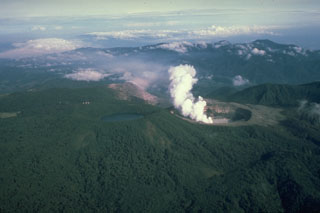Report on Poas (Costa Rica) — September 1993
Bulletin of the Global Volcanism Network, vol. 18, no. 9 (September 1993)
Managing Editor: Edward Venzke.
Poas (Costa Rica) Ongoing minor activity in crater lake; seismicity remains moderate
Please cite this report as:
Global Volcanism Program, 1993. Report on Poas (Costa Rica) (Venzke, E., ed.). Bulletin of the Global Volcanism Network, 18:9. Smithsonian Institution. https://doi.org/10.5479/si.GVP.BGVN199309-345040
Poas
Costa Rica
10.2°N, 84.233°W; summit elev. 2697 m
All times are local (unless otherwise noted)
Fumarolic activity continued at Poás on the N and NW sides of the 200-m-diameter lake in the active crater. Conditions at Poás have remained similar since last reported in June 1993. As before, localized fumarolic activity within the lake center exhibited both constant bubbling, and occasional geysering that reached as high as several meters above the lake surface. Escaping gases made strong jet-like sounds in June but these had clearly diminished by August. The bulk of the lake was turquoise green and had a temperature of 64°C.
During September the seismic station POA2, located 2.7 km SW of the main crater, registered a total of 3,865 low-frequency events. This was similar to levels of the past several months, and reflects a decrease from just over 6,000 events registered in January and February 1993 (figure 46).
Geological Summary. The broad vegetated edifice of Poás, one of the most active volcanoes of Costa Rica, contains three craters along a N-S line. The frequently visited multi-hued summit crater lakes of the basaltic-to-dacitic volcano are easily accessible by vehicle from the nearby capital city of San José. A N-S-trending fissure cutting the complex stratovolcano extends to the lower N flank, where it has produced the Congo stratovolcano and several lake-filled maars. The southernmost of the two summit crater lakes, Botos, last erupted about 7,500 years ago. The more prominent geothermally heated northern lake, Laguna Caliente, is one of the world's most acidic natural lakes, with a pH of near zero. It has been the site of frequent phreatic and phreatomagmatic eruptions since an eruption was reported in 1828. Eruptions often include geyser-like ejections of crater-lake water.
Information Contacts: E. Fernández, J. Barquero, R. Van der Laat, F. de Obaldia, T. Marino, V. Barboza, and R. Sáenz, OVSICORI; G. Soto, ICE.

